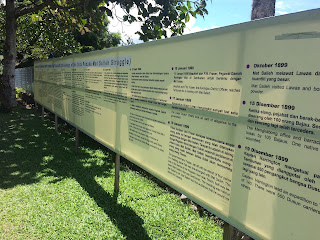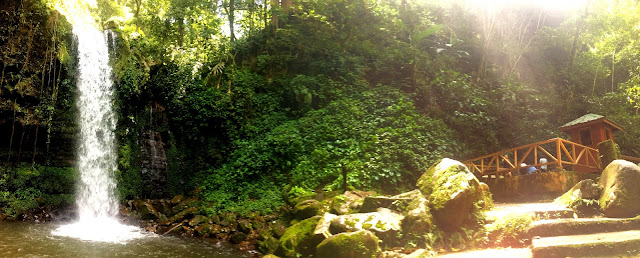After we back to Kota Kinabalu from Tambunan, we have a good rest and the next day we depart to Tuaran, the horse town.
Tuaran is a small town where the Royal Sabah Turf Club is located. With the horse racing history, there established a Cowboy Town at Sabandar Tuaran - a mini theme park with western cowboy features that attract many here for family and leisure outing.
The entrance fee is RM10 per adult and RM5 per child, both complement with a welcome drink claimable at Bamboo Restaurant in the Mangrove Park.
The first building that welcome us was the Cowboy Lodge and a display of antique car and collections for visitors to take pictures.
We were more attracted by the real horses and the mangrove park.

At the Bamboo Restaurant there keeps a few geese which most children find it fascinating.
While queuing up for our drinks, Baby Forrest went to observe the geese.
The bamboo restaurant apparently is totally made of bamboo. Including the tables, chairs, the walkway, the wall, it's almost bamboo everywhere. We like it there, it's shady.
People who built the walkway around the park has carefully thought of the mangrove trees by minimizing its cutting to the trees.
Importance of Mangrove
Mangrove is very important in maintaining the balance of ecosystem of nature. It is a nature habitat of many sea creatures, source of food, a natural barrier of sea corrosion and tides, supply of food and woods for human, and so on.
This is also an educational place for children as well as adults. Hope the owner of this place can put up more signage on the information of mangrove for the public.
We spotted a snake sleeping on a tree branch. With much amaze, we quickly walk away from that area.
The tree grow in the middle of the walkway. They make a hole for the tree to grow.
Since we are in Tuaran already, might as well visit the Crocodile Farm which is just a short distance away from the cowboy farm.
The admission fee for Malaysian adult is RM16 and RM8 for child.
The crocodile farm accommodates more than 1000 crocodiles. There is a exhibition of crocodile and a few other mammals' replica for tourists to take picture. We walked pass a petting zoo-like area with rabbits and fish pond, a butterfly farm without butterflies then walked into the crocodile farm area.
The reptiles are laying on the land sunbathing. Some tourists bought meat (like RM10 or 20 per tin) and poured the meat in the middle of the lake for the crocodiles to eat. Bigger and stronger ones get the meat.
We waited for 2.15pm crocodile show. Nothing much that I like to describe this circus-like show. I just don't like how animal becomes human's entertainment.
May all the animals in the farm live happily.


































